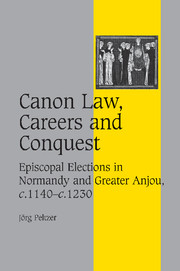Book contents
- Frontmatter
- Contents
- List of maps
- List of tables
- Preface
- Editorial note
- List of abbreviations
- 1 INTRODUCTION
- 2 ELECTORAL THEORY
- 3 ELECTORAL PRACTICE: NORMANDY
- 4 ELECTORAL PRACTICE: GREATER ANJOU
- 5 THE EPISCOPACY IN NORMANDY AND GREATER ANJOU
- 6 THE IMPACT OF THE CAPETIAN CONQUEST OF 1204/6
- 7 CONCLUSION
- APPENDICES
- Bibliography
- Index
- Cambridge Studies in Medieval Life and Thought Fourth Series
5 - THE EPISCOPACY IN NORMANDY AND GREATER ANJOU
Published online by Cambridge University Press: 09 August 2009
- Frontmatter
- Contents
- List of maps
- List of tables
- Preface
- Editorial note
- List of abbreviations
- 1 INTRODUCTION
- 2 ELECTORAL THEORY
- 3 ELECTORAL PRACTICE: NORMANDY
- 4 ELECTORAL PRACTICE: GREATER ANJOU
- 5 THE EPISCOPACY IN NORMANDY AND GREATER ANJOU
- 6 THE IMPACT OF THE CAPETIAN CONQUEST OF 1204/6
- 7 CONCLUSION
- APPENDICES
- Bibliography
- Index
- Cambridge Studies in Medieval Life and Thought Fourth Series
Summary
So far the analysis has focused on the bishop as an individual. His family and his career have been considered in reconstructing possible motives for his election. However, the information on the bishop's personal background also provides a clearer view of the bishops as a group. Thus the composition of the episcopacy, the texture of this particular social group, and the nature and dynamics of ecclesiastical careers leading to an episcopal see – in other words the entry routes to the episcopacy – become visible.
THE COMPOSITION OF THE EPISCOPACY IN NORMANDY AND GREATER ANJOU
Sixty-one elections were successfully completed in Normandy and Greater Anjou between c. 1140 and c. 1230. Since Rotrou, William de Chemillé, and Maurice were chosen twice, the total of individuals elected was fifty-eight. They had fifty-eight different life stories to tell, but they may also have shared common features that shaped their appearance as a group. The examination of the bishop's social origins, the location and type of their last office prior to election, and their affiliation to secular or regular clergy, all help to determine characteristics of the episcopacy of Normandy and Greater Anjou during our period.
The social origins of the bishops in Normandy and Greater Anjou are difficult to establish with precision. Often they are unknown, and even if a bishop's family can be identified it is not necessarily known to which social layer a family belonged.
- Type
- Chapter
- Information
- Canon Law, Careers and ConquestEpiscopal Elections in Normandy and Greater Anjou, c.1140–c.1230, pp. 211 - 237Publisher: Cambridge University PressPrint publication year: 2007



